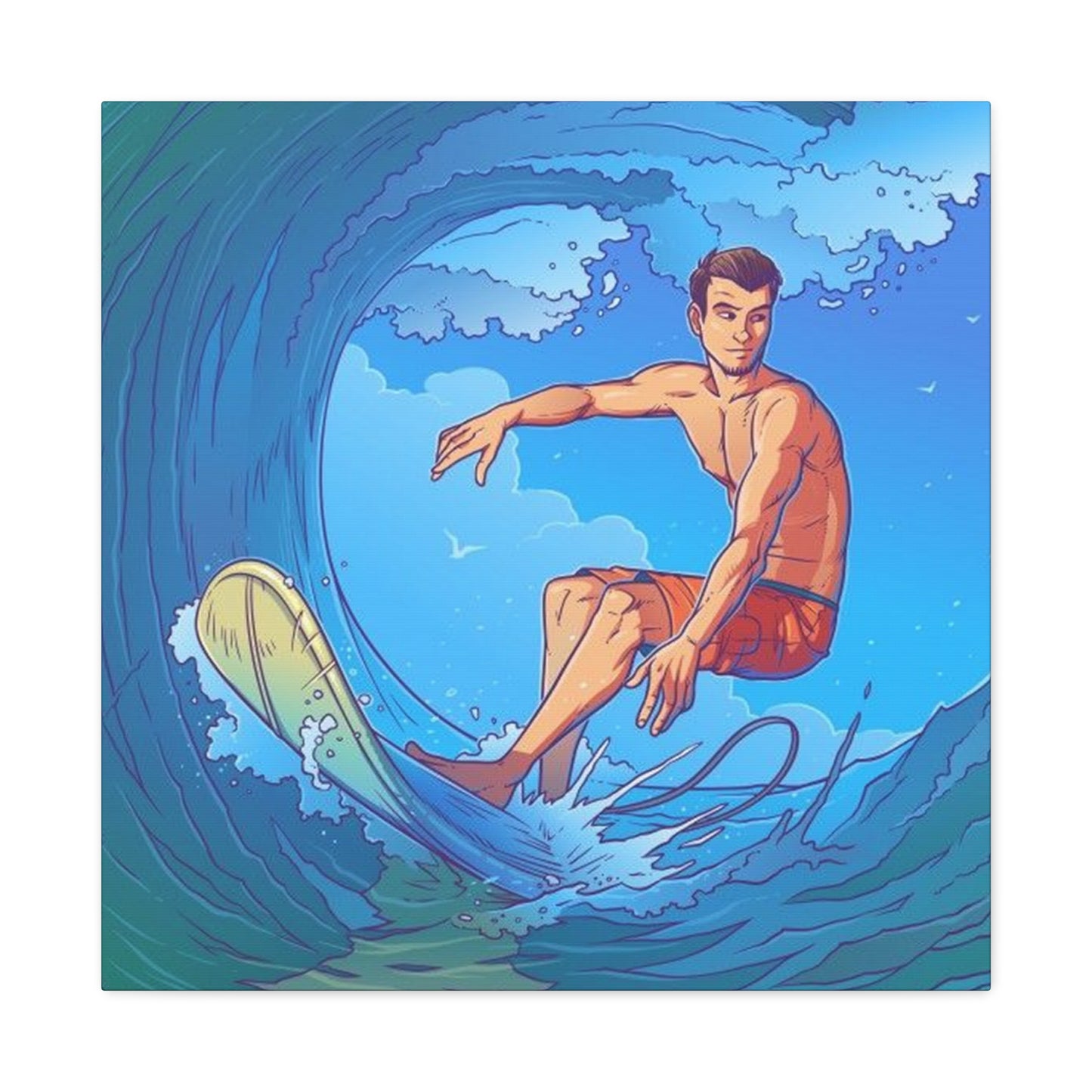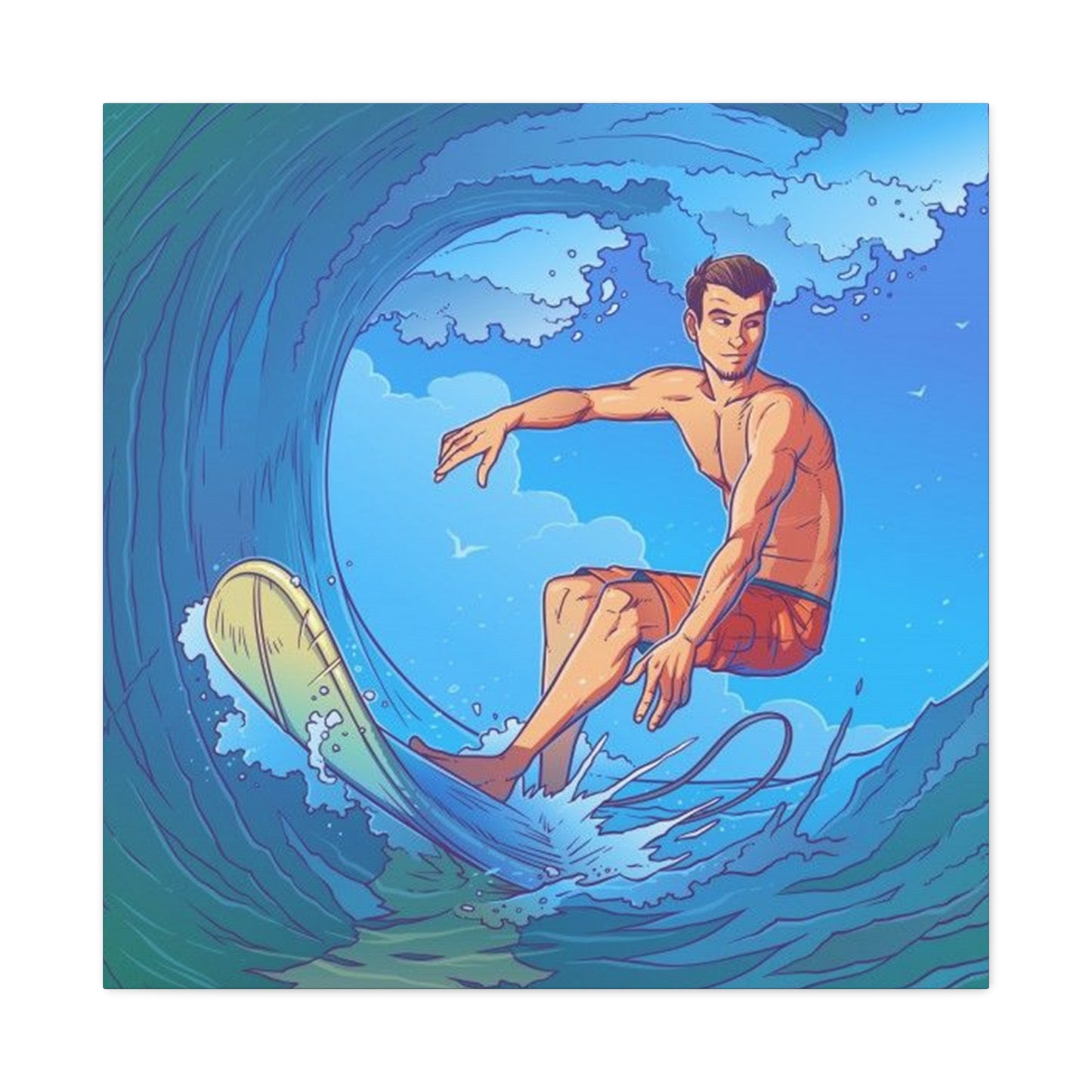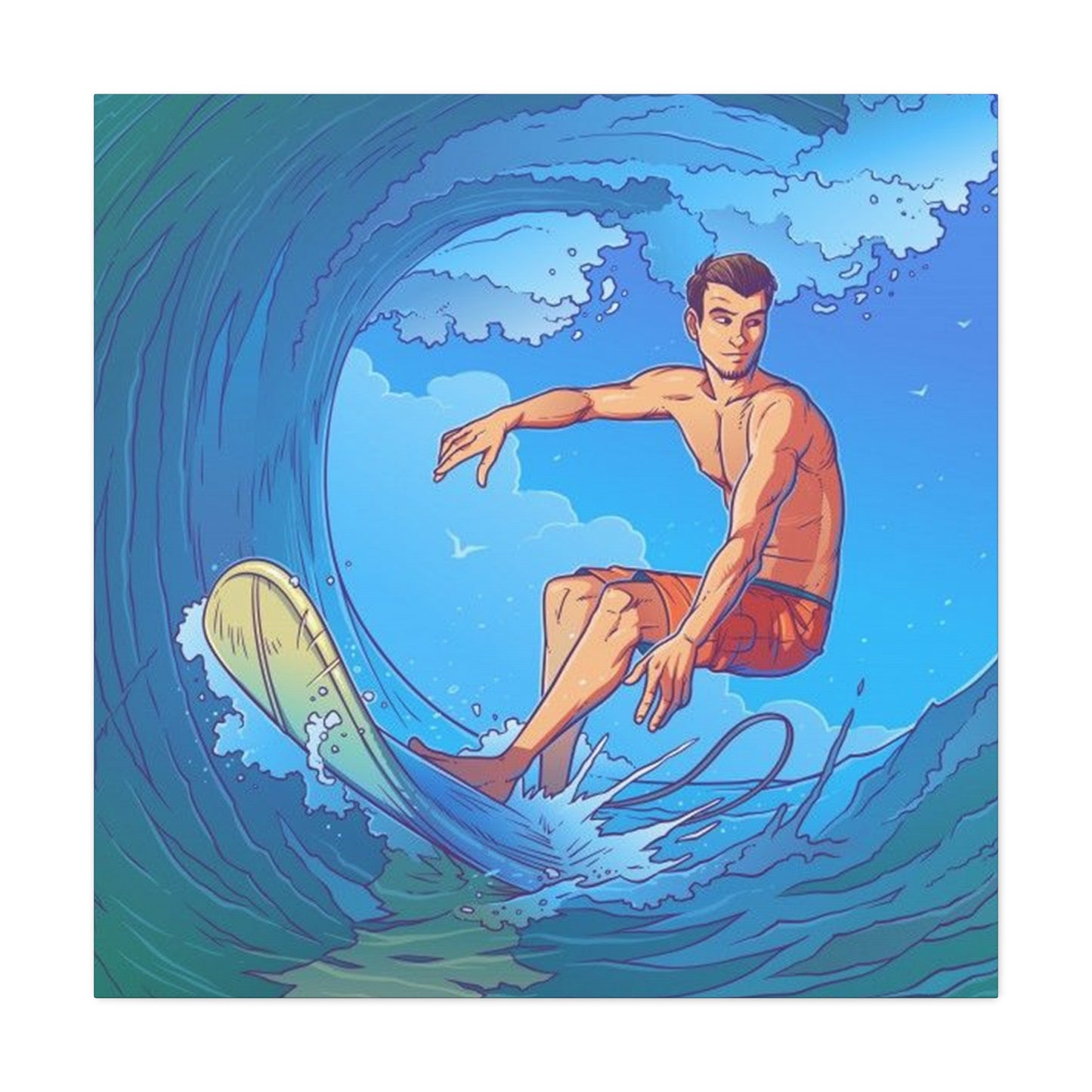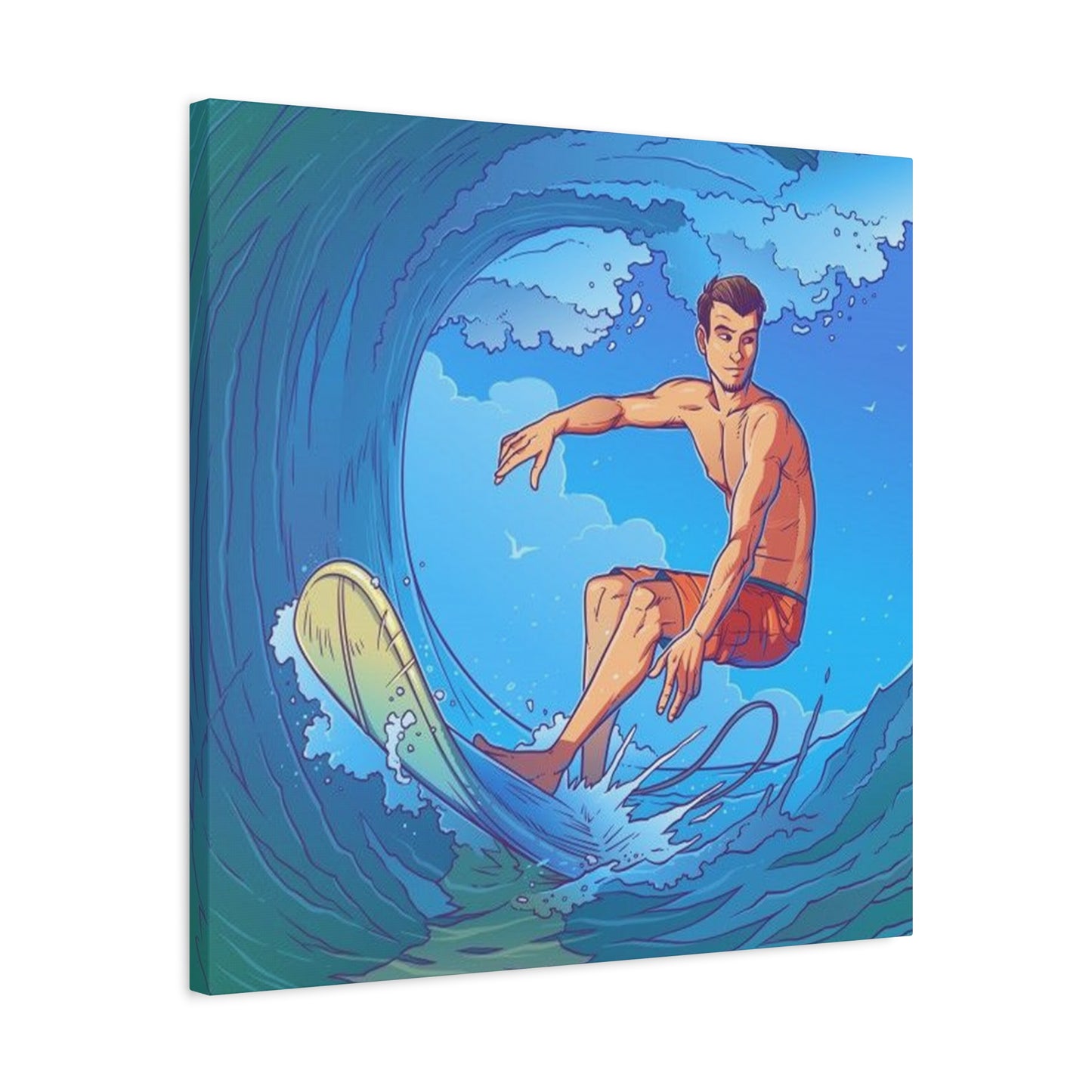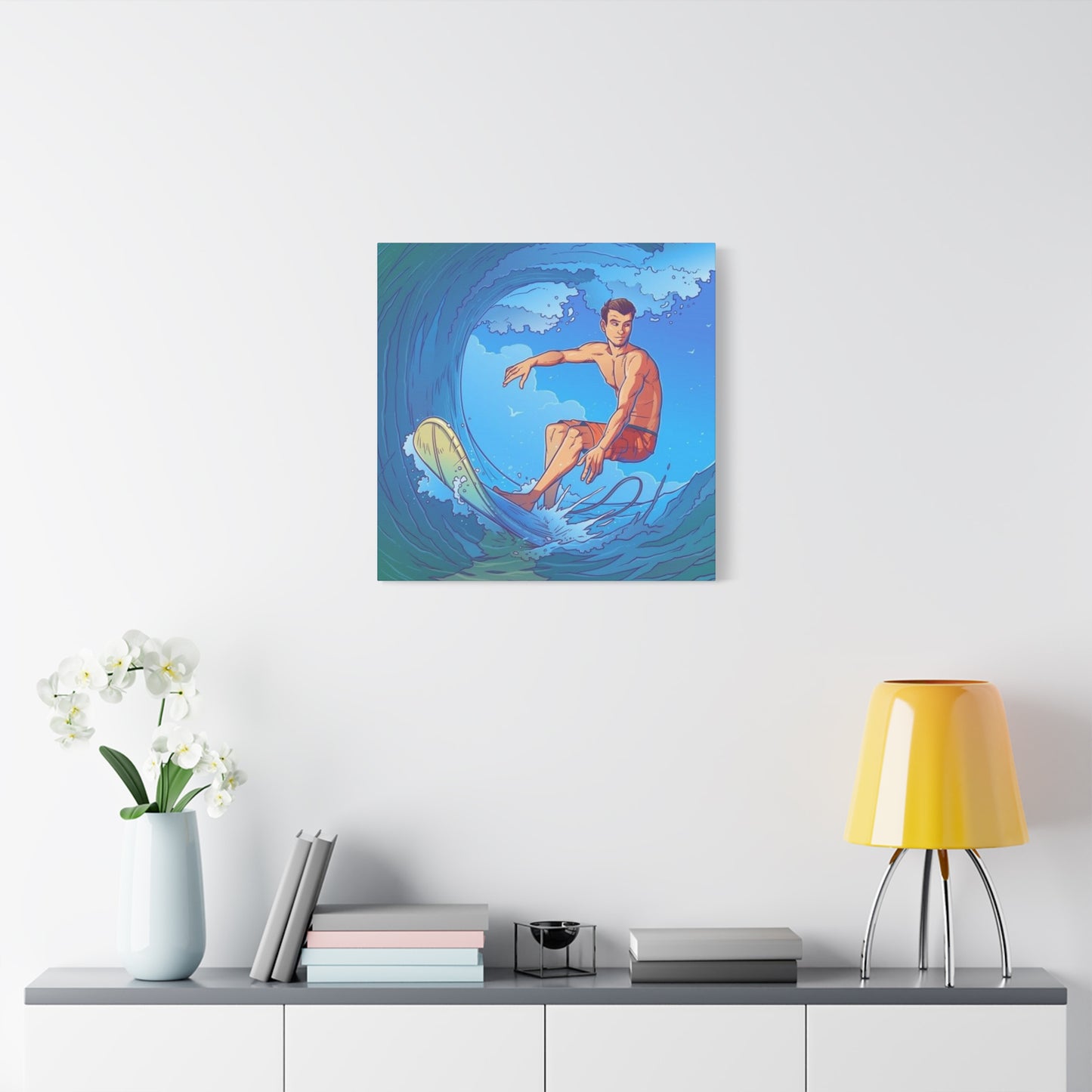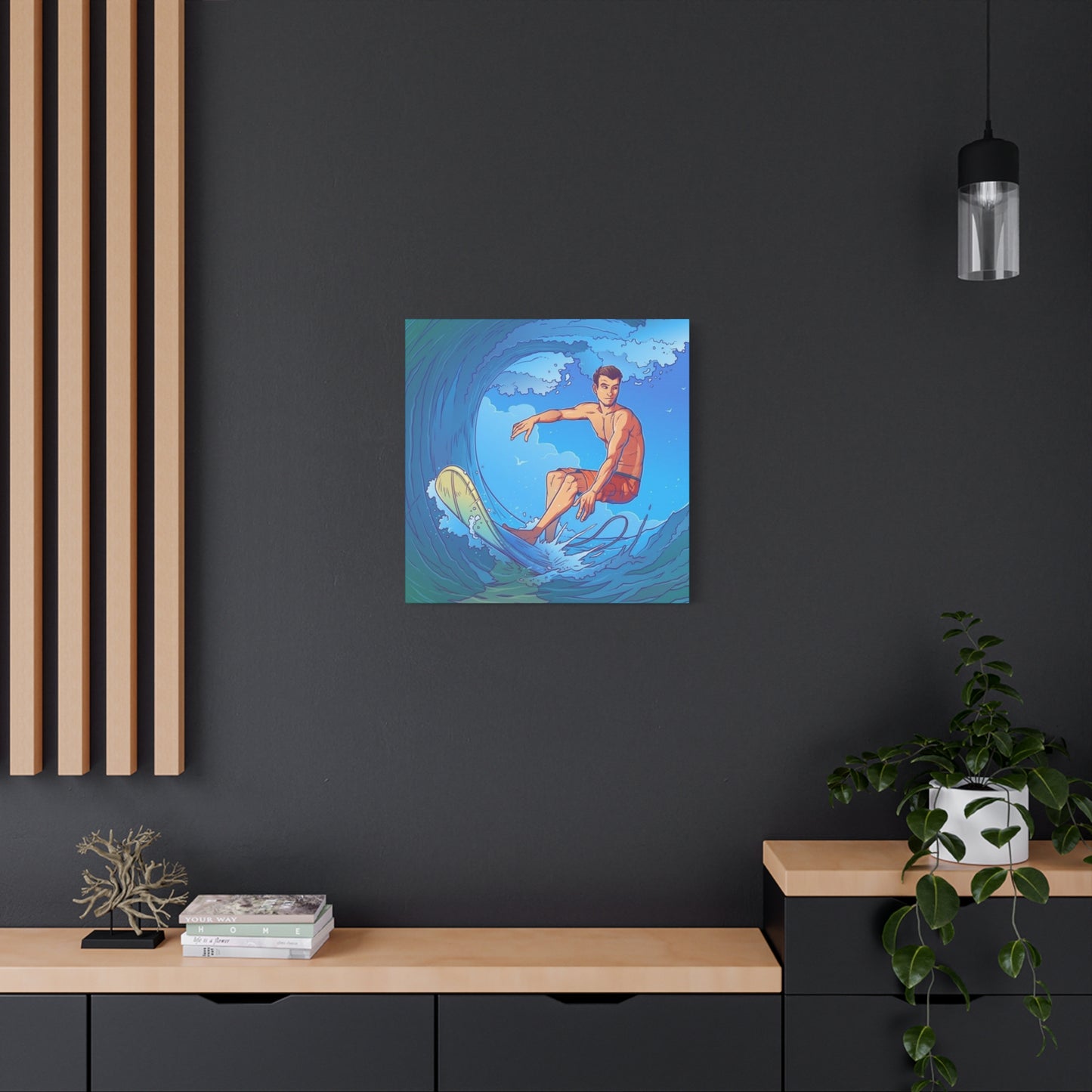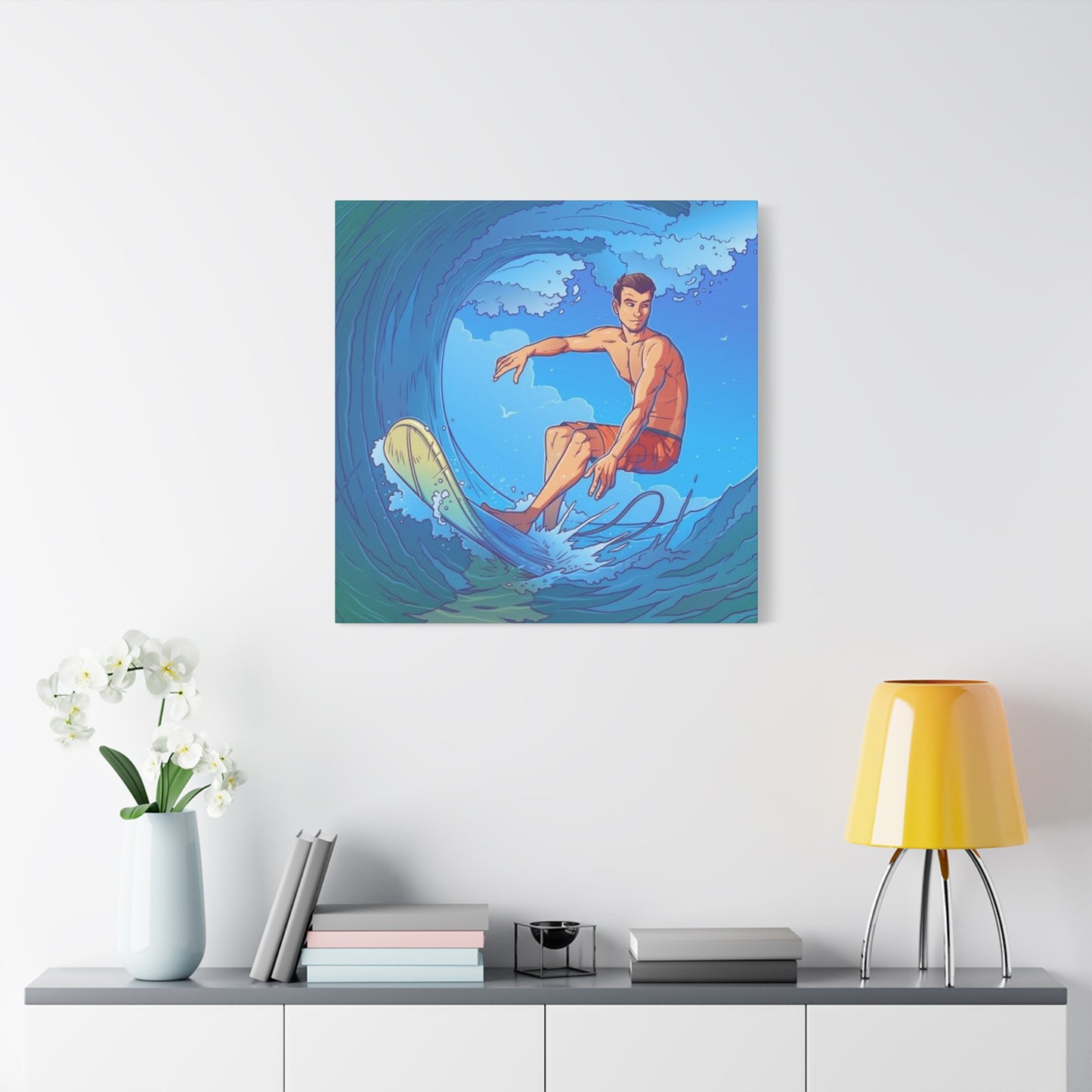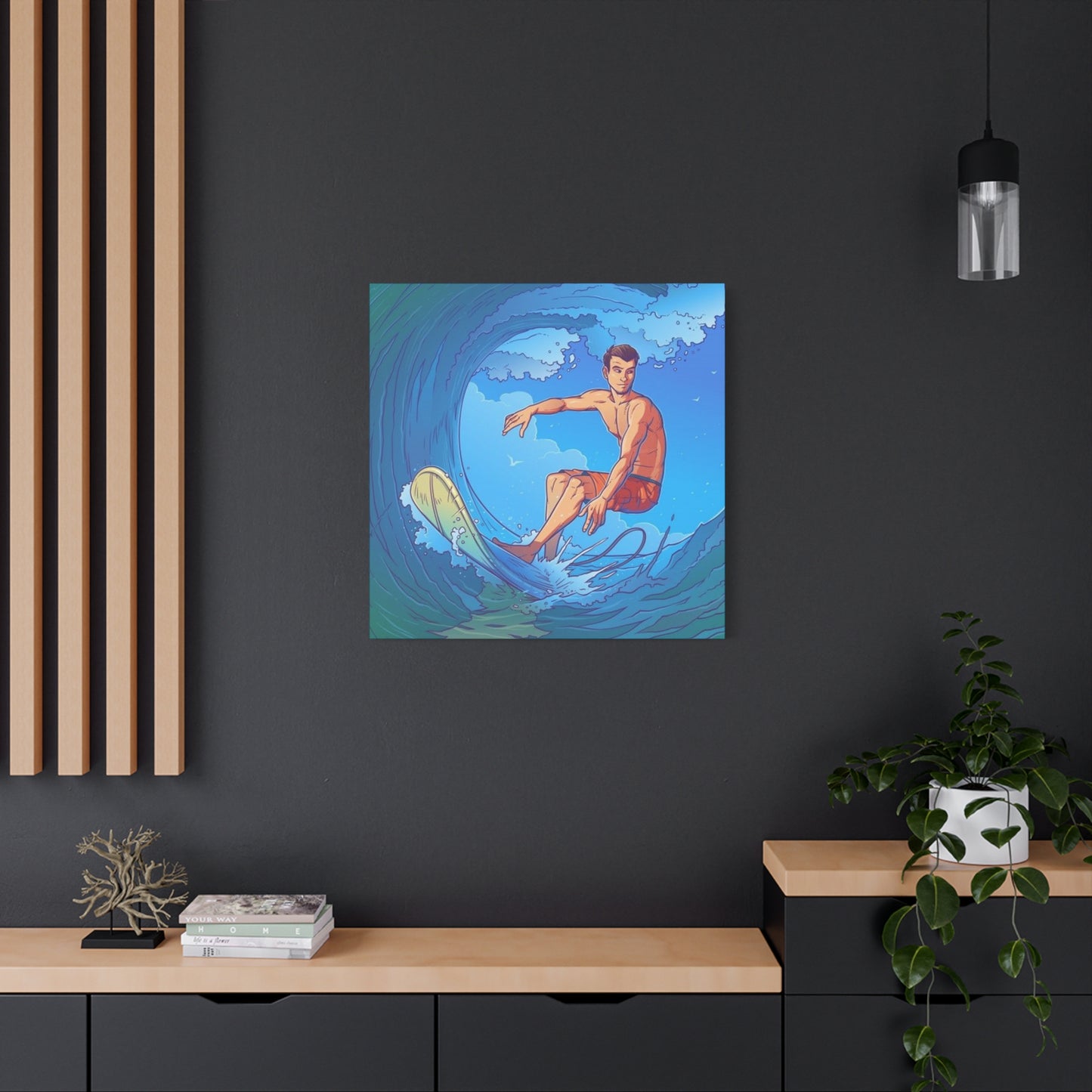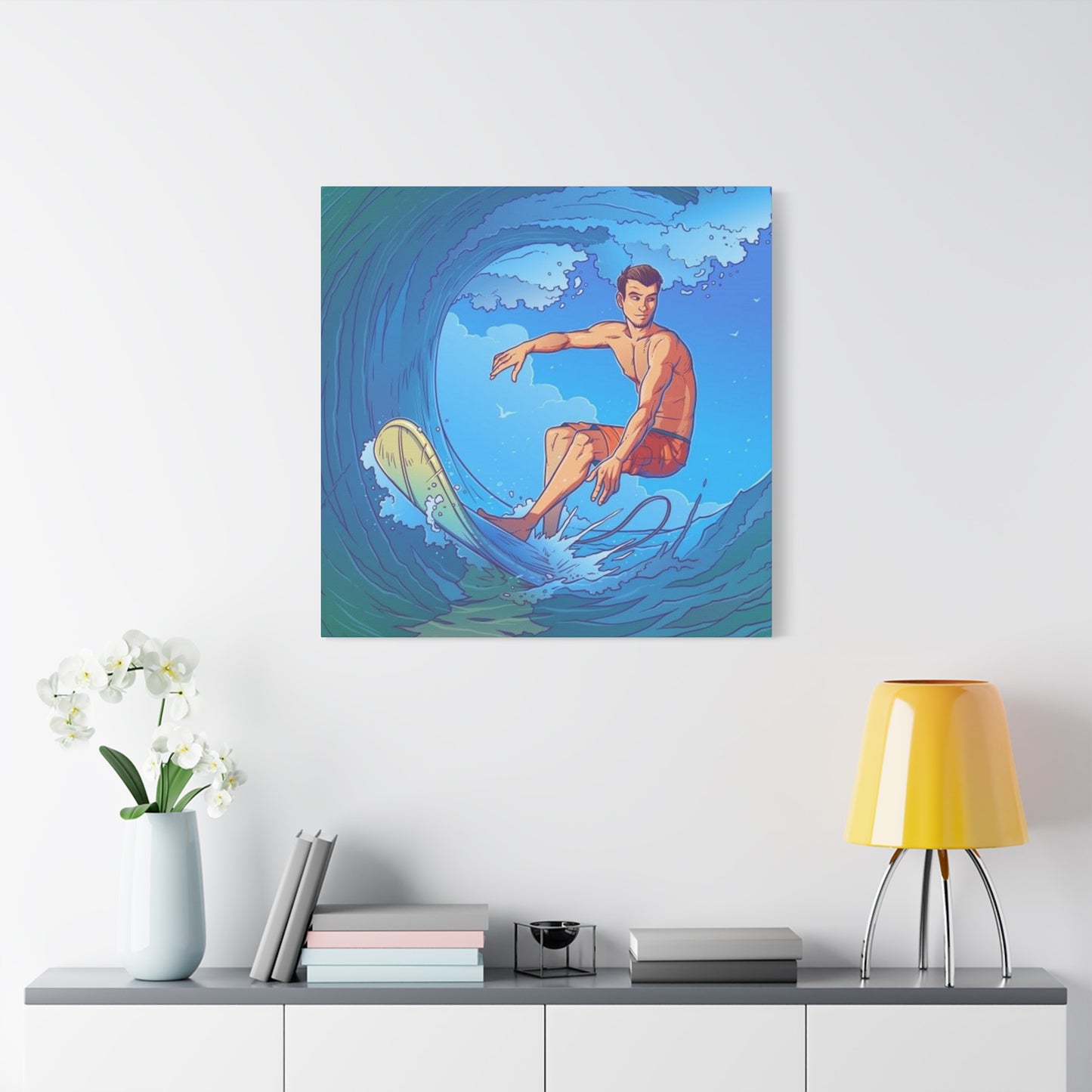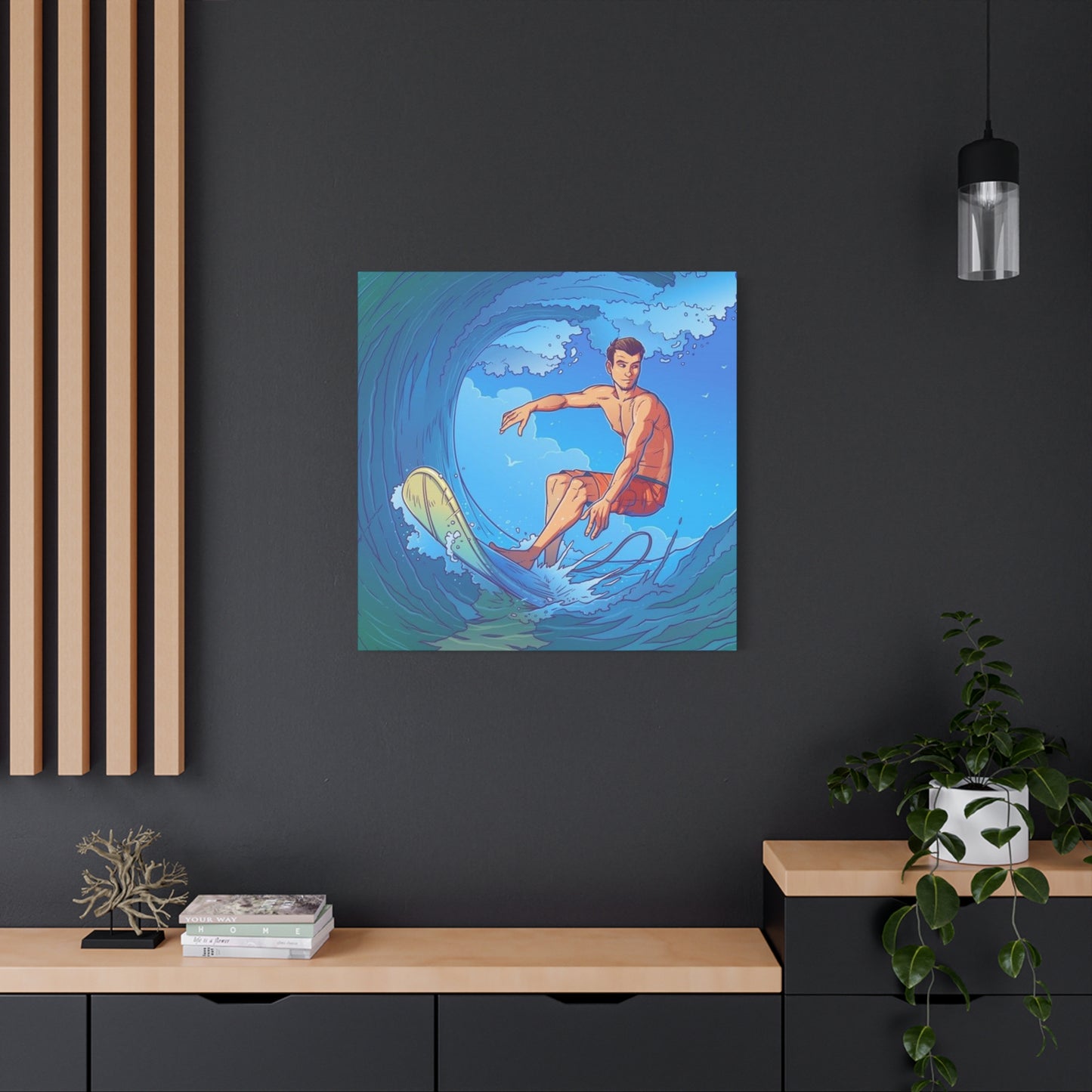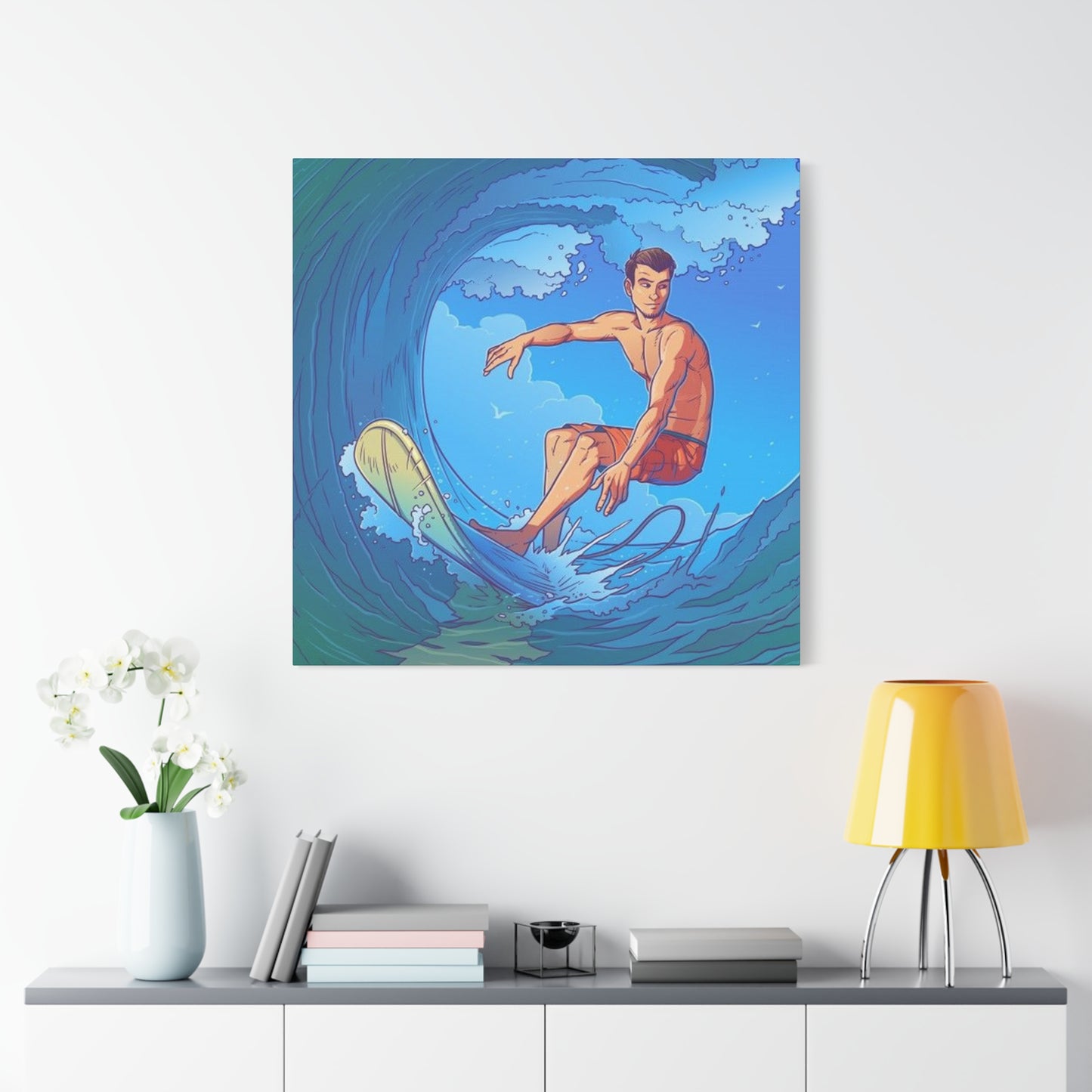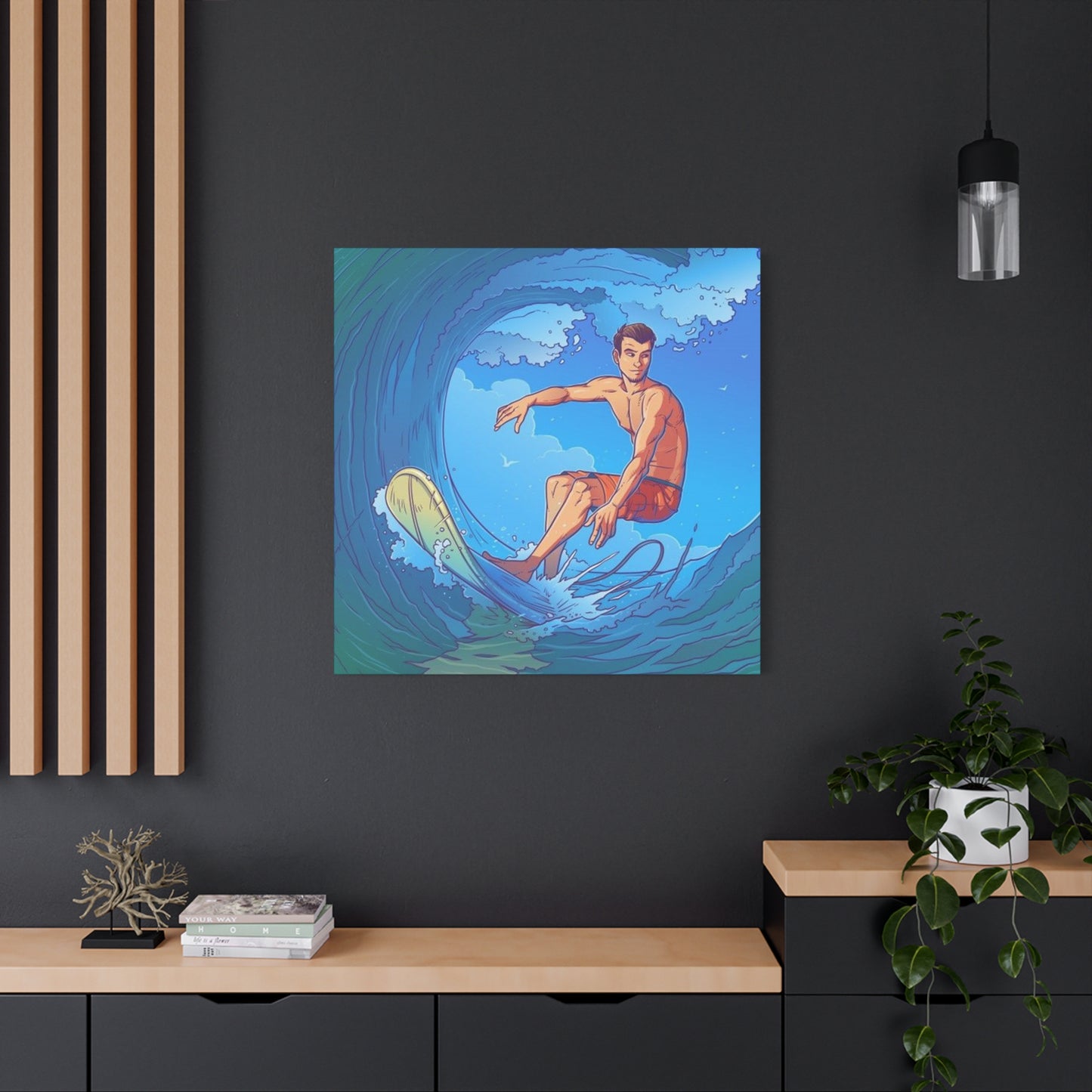Artistic Flow of Wave Surfing: How Drawing Wall Art Brings the Ocean’s Motion to Life
The connection between humans and the ocean runs deep through centuries of coastal living, adventure seeking, and artistic expression. When we talk about decorating homes with nautical themes, few elements capture the raw power and beauty of the sea quite like wave surfing artwork displayed on canvas prints. These pieces transform ordinary walls into dynamic showcases of ocean energy, athletic prowess, and natural wonder that speaks to both surfers and ocean enthusiasts alike.
Canvas prints featuring wave surfing scenes have become increasingly popular in modern interior design, offering homeowners a chance to bring the excitement of coastal living into their everyday environments. Whether you live steps from the beach or hundreds of miles inland, these artistic representations create an instant connection to the rhythmic dance between surfer and wave, capturing moments of perfect balance, courage, and natural beauty frozen in time.
The appeal of wave surfing artwork extends far beyond simple decoration. These pieces carry emotional weight, telling stories of adventure, freedom, and the eternal human desire to connect with nature's most powerful forces. Each canvas becomes a window into a world where gravity seems negotiable, where water transforms into a playground, and where the boundary between human achievement and natural beauty blurs into something truly spectacular.
The Cultural Significance of Ocean Wave Art in Modern Homes
Throughout human history, societies living near coastlines have maintained special relationships with the ocean. Ancient Polynesian cultures revered the sea, developing sophisticated navigation techniques and wave riding traditions that predate modern surfing by centuries. These cultural foundations established wave interaction as more than recreation but rather as a spiritual practice connecting humans with elemental forces.
When we incorporate wave surfing drawings into our living spaces, we tap into this rich cultural heritage. The artwork serves as more than decoration, functioning as a daily reminder of adventure possibilities, natural power, and the courage required to engage with forces larger than ourselves. In contemporary homes, these pieces bridge the gap between indoor comfort and outdoor excitement, bringing visceral energy into controlled environments.
The psychological impact of ocean imagery in residential spaces has been studied extensively by environmental psychologists. Research indicates that viewing water scenes, particularly dynamic representations like surfing imagery, can reduce stress levels, lower blood pressure, and promote feelings of calm and well-being. The paradox of finding peace in images of powerful waves speaks to our complex relationship with natural forces that are simultaneously threatening and life giving.
Canvas prints depicting wave surfing scenes work particularly well in various interior design schemes. Coastal themed rooms obviously benefit from such additions, but these artworks also provide striking contrast in urban industrial spaces, softening hard edges with organic curves and fluid motion. The versatility of wave imagery allows it to complement minimalist aesthetics through simple line work or enrich maximalist approaches with detailed, color saturated compositions.
Visual Elements That Define Powerful Wave Surfing Compositions
Creating compelling wave surfing artwork requires understanding the visual components that make these scenes so captivating. The wave itself typically dominates the composition, with artists carefully rendering the water's texture, transparency, and movement. Successful pieces capture the moment of perfect formation when the wave reaches its most photogenic state, the barrel forming or the lip beginning its curl.
The surfer's position within the frame carries significant compositional weight. Placement too central can feel static, while positioning toward the edges suggests motion and progression through space. Artists must balance the human figure against the massive water formation, typically keeping the surfer relatively small to emphasize the wave's scale and power. This size relationship underscores the courage required for the sport while celebrating nature's magnificence.
Color palettes in wave surfing artwork range dramatically depending on artistic intent and the specific ocean environment depicted. Tropical scenes might feature brilliant turquoise waters under cobalt skies, while temperate or cold water compositions lean toward steely grays, deep blues, and whites that suggest power and challenge. The color choices dramatically affect the emotional tone, with warmer palettes suggesting approachability and cooler tones emphasizing majesty and respect.
Light plays a crucial role in successful wave compositions. Backlit waves glow with translucent beauty, revealing water's inner structure and creating dramatic silhouettes. Front lighting emphasizes texture and spray, adding tactile quality to the visual experience. The time of day suggested by lighting choices affects mood significantly, with dawn and dusk scenes carrying contemplative qualities while midday representations feel energetic and immediate.
Texture representation separates exceptional wave artwork from mediocre attempts. Water possesses infinite textural variety from glassy smoothness to chaotic foam and spray. Canvas prints that successfully convey these textural differences create more immersive viewing experiences, allowing observers to almost feel the water's movement and power through visual cues alone.
Capture Wave Motion and Energy
Artists working in drawing media face unique challenges when representing wave surfing scenes. Unlike photography, which captures instantaneous reality, drawing requires translating observed motion into static marks that suggest movement. Line quality becomes paramount, with varied line weights indicating depth, movement direction, and energy levels throughout the composition.
Contour drawing techniques work effectively for establishing basic wave structure. Artists trace the major curves and forms, creating the underlying architecture upon which details build. These initial contours must capture the wave's essential gesture, its overall movement pattern and energy flow. Successful contour work provides a strong foundation that guides subsequent rendering and detail addition.
Hatching and cross hatching techniques add dimensionality and value variation to wave drawings. Water's reflective nature creates complex light patterns that hatching can effectively represent. Directional hatching following wave contours reinforces movement suggestions while cross hatching in transitional areas builds form and weight. The spacing and density of these marks control value relationships and atmospheric depth.
Stippling offers another approach for rendering wave textures, particularly useful for depicting spray and foam where water transitions to air. The technique's granular nature mimics water droplet patterns naturally, creating convincing representations of breaking wave dynamics. Stippling requires patience but produces unique textural qualities difficult to achieve through other mark making approaches.
Charcoal and graphite each offer distinct advantages for wave drawing. Charcoal's soft, blendable nature suits atmospheric effects and dramatic tonal ranges, ideal for stormy seas or dawn lighting conditions. Graphite provides greater control for detailed rendering, working well for technical accuracy and subtle gradations. Many artists combine media, using each material's strengths for different compositional elements.
Contemporary digital drawing tools have expanded possibilities for wave surfing artwork. Tablets and styluses allow artists to work in layers, adjusting elements independently and experimenting with variations efficiently. Digital media facilitates color exploration and enables artists to create multiple versions from single drawings. However, traditional media maintains appeal for its tactile qualities and the authentic marks that hand drawn work provides.
Canvas Print Production Methods and Quality Considerations
Transforming wave surfing drawings into wall ready canvas prints involves several technical processes that affect final product quality. Understanding these production methods helps consumers make informed purchasing decisions and artists prepare artwork appropriately for reproduction. The journey from original artwork to finished canvas involves digitization, printing, stretching, and finishing stages.
High resolution scanning or photography captures original artwork for digital reproduction. Resolution requirements depend on intended print dimensions, with larger prints demanding higher capture resolution to maintain detail and prevent pixelation. Professional scanning services typically capture at 600 dpi or higher, ensuring adequate information for various print sizes without quality degradation.
Canvas material selection significantly impacts finished print appearance and longevity. Cotton canvas offers excellent color absorption and archival stability, making it popular for fine art reproduction. Polyester canvas provides durability and resistance to environmental factors like humidity, though some artists prefer cotton's texture and historical associations with traditional painting. Blended materials attempt to combine advantages from both fiber types.
Printing technology affects color accuracy, detail resolution, and print longevity. Giclée printing has become the standard for high quality canvas reproduction, using archival inks and sophisticated color management to produce museum quality results. The term giclée specifically refers to inkjet printing meeting certain quality standards, including minimum resolution and archival ink requirements. These prints can last decades without significant fading when properly cared for.
Stretching printed canvas over wooden frames requires skill to achieve proper tension without warping or creating loose areas. Gallery wrap stretching continues the printed image around frame edges, creating a finished look that requires no additional framing. Museum wrapping places the image only on the canvas front with neutral color continuing around sides, providing a different aesthetic suitable for certain design contexts.
Protective coating application adds durability and UV resistance to finished canvas prints. Water based varnishes provide protection while allowing canvas texture to remain visible and tactile. These coatings guard against dust accumulation, moisture damage, and environmental pollutants that can degrade prints over time. Proper coating significantly extends display life, particularly in challenging environments.
Selecting the Perfect Wave Surfing Canvas for Your Space
Choosing appropriate wave surfing artwork involves considering multiple factors beyond simple aesthetic preference. Successful art placement enhances both the artwork and the surrounding environment, creating harmonious relationships between pieces and their settings. Dimensional considerations, color relationships, and thematic consistency all contribute to effective selection and placement.
Scale relationship between artwork and wall space dramatically affects visual impact. Oversized pieces create bold focal points that dominate rooms and set design tones. Undersized artwork disappears on large walls, failing to achieve intended impact. General design guidelines suggest leaving some negative space around artwork while ensuring pieces occupy sufficient wall area to register as significant design elements rather than afterthoughts.
Room function influences appropriate artwork selection. Living spaces accommodate dramatic, conversation starting pieces that guests will observe and discuss. Bedroom artwork typically adopts calmer approaches, with gentler wave scenes promoting relaxation rather than excitement. Office environments might feature motivational surfing imagery suggesting challenge and achievement. Matching artwork energy to room purpose creates coherent environments supporting intended activities.
Color coordination between wave surfing prints and existing room palettes requires thoughtful consideration. Artwork can either harmonize with established color schemes, picking up existing hues and reinforcing them, or provide strategic contrast that energizes spaces. Neutral rooms particularly benefit from artwork introducing color, while colorful spaces might embrace artwork echoing dominant tones or adding complementary accents.
Lighting significantly affects canvas print appearance and should inform placement decisions. Natural light brings vibrancy to colors but requires UV protection to prevent fading. Artificial lighting offers control but must be positioned to avoid glare on canvas surfaces. Directional lighting can dramatically enhance dimensional aspects of canvas prints, creating shadows that emphasize texture and depth.
Multiple piece arrangements expand design possibilities for wave surfing artwork. Diptychs and triptychs tell extended visual stories, showing wave progression or different surfing moments. Gallery walls combining various sized prints create dynamic installations with visual rhythm and variety. When arranging multiple pieces, maintaining consistent framing styles or complementary color relationships helps unify collections.
Ocean and Wave Imagery
The colors dominating wave surfing artwork carry psychological associations that influence viewer responses and room atmospheres. Understanding color psychology helps in selecting pieces that create desired emotional environments while reflecting personal preferences and design goals. Ocean imagery naturally emphasizes blues and greens, but variations in hue, saturation, and value dramatically affect mood.
Blue, the most common color in wave artwork, carries complex associations. Light blues suggest tranquility, openness, and peaceful contemplation. These shades work well in bedrooms and meditation spaces, promoting relaxation and mental clarity. Deeper blues convey stability, confidence, and depth, suitable for offices and formal living areas. Navy and midnight blues add sophistication and drama, grounding spaces with authoritative presence.
Turquoise and aqua tones blend blue's calming properties with green's refreshing qualities. These vibrant shades energize spaces while maintaining connection to water themes. Tropical wave scenes frequently feature these colors, evoking vacation memories and escape fantasies. Psychologically, these hues promote communication and creative thinking, making them suitable for social spaces and creative work areas.
Green present in wave artwork often appears as underwater tones or background vegetation. Green universally represents growth, renewal, and natural vitality. In ocean contexts, green can also suggest power and mystery, particularly in deeper jade tones representing fathomless depths. These associations make green accented wave artwork appropriate for spaces dedicated to personal development or environmental connection.
White foam and spray introduce crucial contrast in wave compositions while carrying their own psychological weight. White represents purity, energy release, and transformation—themes central to wave breaking moments. Compositions emphasizing white create high key, energetic impressions suitable for active spaces. The interplay between darker water tones and brilliant white spray adds visual excitement and movement suggestion.
Warm accent colors appearing in wave artwork, typically from sunsets, sunrises, or beach elements, dramatically shift emotional tone. Golden yellows and oranges introduce optimism, warmth, and welcoming energy. These warmer palettes make spaces feel more inviting and comfortable, counterbalancing blue's potential coolness. Sunset wave scenes particularly appeal to those seeking dramatic, emotionally rich artwork.
Gray scale or limited color wave drawings offer different psychological benefits. These pieces emphasize form, composition, and tonal relationships over chromatic impact. Monochromatic artwork brings sophistication and versatility, easily integrating with varied color schemes. The restraint of limited palettes allows other design elements to carry color responsibility while artwork provides visual interest through form and contrast.
Artistic Styles in Wave Surfing Canvas Prints
Wave surfing artwork manifests across diverse artistic styles, each offering distinct aesthetic experiences and appealing to different preferences. Understanding style characteristics helps buyers identify pieces matching their sensibilities while appreciating the breadth of creative approaches applied to this subject matter. From photorealistic renderings to abstract interpretations, wave art encompasses remarkable stylistic range.
Realistic wave drawings aim to capture observed reality with maximum accuracy. These pieces showcase technical skill, demonstrating artist ability to render complex forms, textures, and lighting convincingly. Realism appeals to viewers who appreciate craftsmanship and want artwork that faithfully represents actual surfing experiences. These pieces often feature impressive detail in water droplets, facial expressions, and equipment rendering.
Impressionistic wave artwork prioritizes capturing the essence and feeling of moments over precise detail. These pieces use loose brushwork or mark making to suggest forms and movement. Colors might intensify beyond natural observation to heighten emotional impact. Impressionistic approaches often feel more energetic and spontaneous than realistic work, conveying the excitement and fluidity of surfing through artistic technique itself.
Abstract wave compositions reduce surfing scenes to essential elements like curves, colors, and directional forces. These pieces might be barely recognizable as waves, instead focusing on rhythm, movement, and visual relationships. Abstract work particularly suits modern interiors and viewers who appreciate conceptual approaches. The ambiguity invites personal interpretation, allowing each viewer to project their own meanings and associations.
Line art wave drawings emphasize contours and outlines, often minimizing or eliminating tonal variation. These pieces possess graphic quality and decorative appeal, working particularly well in contemporary interiors. Line work can range from loose and gestural to precise and technical. The simplicity of approach creates visually quiet pieces that provide presence without overwhelming spaces.
Pop art influenced wave surfing prints embrace bold colors, graphic simplification, and cultural commentary. These pieces often feature high contrast, flattened forms, and vibrant unrealistic colors. Pop approaches transform surfing imagery into icons, emphasizing the sport's cultural significance and visual impact. Such artwork makes strong statements and energizes spaces with contemporary edge.
Traditional illustrative styles bring narrative quality to wave surfing artwork. These pieces often include multiple figures, environmental context, and storytelling elements. Illustration informed work might show entire beach scenes with various surfing stages visible simultaneously. This approach appeals to those who enjoy artwork with layers of visual information and discoverable details.
Evolution of Surfing in Visual Arts
Surfing's representation in visual arts traces back centuries before modern canvas prints existed. Understanding this historical context enriches appreciation for contemporary wave surfing artwork while revealing how artistic conventions developed over time. From ancient Hawaiian petroglyphs to twentieth century surf culture explosion, the artistic documentation of wave riding reflects changing technologies, cultural attitudes, and artistic movements.
Ancient Polynesian societies left the earliest known surfing representations through petroglyphs carved into volcanic rock. These simplified figures riding waves served ceremonial and communicative purposes, recording important cultural practices and spiritual beliefs. The stylization in these early images established conventions of showing human figures in dynamic relationship with wave forms that continue influencing contemporary artwork.
European explorers and artists encountering Hawaiian surf culture in the late eighteenth and early nineteenth centuries created the first Western documentation of wave riding. These works, primarily watercolors and engravings, portrayed surfing as exotic curiosity rather than athletic pursuit. The romantic movement influenced these depictions, emphasizing noble savage tropes and idealized relationships between indigenous peoples and nature.
Early twentieth century surfing revival, particularly in California and Australia, coincided with modernist art movements. Artists began treating surfing as subject matter worthy of serious artistic attention. Photography became increasingly important in documenting surf culture, though drawn and painted work maintained significance for interpretive possibilities photography couldn't achieve. This period established surfing as legitimate subject for fine art exploration.
The 1960s surf culture boom dramatically increased surfing representation across all media. Poster art became particularly significant, with bold graphics advertising surf films and beach events. These commercial artworks, created for disposable purposes, have achieved collectible status and influenced contemporary surf art aesthetics. The psychedelic movement's influence appears in period surf art through vivid colors and distorted perspectives.
Contemporary surf art encompasses unprecedented stylistic diversity while benefiting from advanced reproduction technologies. Canvas printing democratized access to surf artwork, making professional quality prints affordable for average consumers. Digital tools expanded creative possibilities while traditional media maintained appeal for authenticity. Today's surf art scene includes everything from hyperrealistic paintings to conceptual installations, reflecting surfing's penetration into mainstream consciousness.
The Science and Structure Behind Perfect Wave Formation
Understanding wave mechanics and formation enhances appreciation for surfing artwork's subject matter. Waves represent visible manifestations of energy traveling through water, created by various forces but most commonly by wind. The process transforming open ocean energy into surfable near shore waves involves complex physics that artists must understand to create convincing representations.
Wave generation begins when wind friction transfers energy to water surfaces. Wind duration, strength, and fetch distance determine wave characteristics. Stronger winds blowing longer over greater distances create larger, more powerful waves. This energy travels through water as organized swell, moving across ocean basins until encountering shallower coastal waters where transformation into breaking waves occurs.
As waves approach shorelines and encounter bottom topography, their behavior changes dramatically. Water depth relative to wavelength determines when waves begin feeling bottom influence. Once water depth drops below roughly half the wavelength, waves slow down while subsequent waves continue at higher speeds, causing wave compression and height increase. This shoaling effect creates the vertical rise surfers seek.
Wave breaking occurs when wave height exceeds water depth sustainability. The wave's forward motion can no longer support its structure, causing the crest to pitch forward and cascade down the face. Different bottom contours create various break types. Gradually sloping bottoms produce gently spilling waves, while steep bottoms or reef formations cause dramatic plunging waves that form barrels prized by expert surfers.
Understanding wave anatomy helps artists create accurate representations. The wave face is the smooth forward surface surfers ride, while the shoulder describes unbroken sections beside the breaking portion. The lip represents the pitching crest, and the tube or barrel refers to the hollow space formed when the lip throws forward over the face. Each component presents distinct visual and rendering challenges.
Seasonal and geographical variations in wave characteristics provide diverse artistic subjects. Winter storms in northern latitudes generate powerful swells reaching tropical regions during their summer. Different coastline orientations receive varied swell directions. Reef breaks, point breaks, and beach breaks each produce characteristic wave shapes. This diversity allows artists to explore countless variations while maintaining recognizable wave surfing themes.
Technical Aspects of Drawing Water in Motion
Rendering water convincingly challenges artists across all experience levels and media choices. Water's transparency, reflectivity, and constant motion create complex visual phenomena requiring careful observation and thoughtful technique application. Successful water rendering in wave surfing drawings combines understanding of water's optical properties with mark making skills that suggest movement and energy.
Transparency presents the first major challenge. Water allows light penetration while refracting and reflecting it. This dual nature means underwater forms remain partially visible while surface reflections simultaneously appear. Artists must balance these competing visual information layers, suggesting depth while maintaining surface integrity. Value relationships control this balance, with lighter values typically indicating shallower, more transparent areas.
Wave surfaces display various reflection types depending on smoothness and viewing angle. Glassy water mirrors sky conditions and surrounding objects with remarkable clarity. As surfaces roughen through wind or turbulence, reflections fragment into abstract patterns. Breaking waves lose reflective capacity entirely, transforming into opaque white foam. Artists must observe and render these varying states within single compositions.
The transition from solid water to airborne spray demands special attention in wave drawings. This transformation involves water droplets separating from the main body, creating mist clouds with unique light scattering properties. Spray often appears lighter and more diffuse than solid water, requiring different mark making approaches. Stippling, loose hatching, or suggestive marks work better than dense, defined rendering for these transitional zones.
Foam patterns resulting from wave turbulence follow predictable organizational principles despite appearing chaotic. Foam forms directional streams following water movement and collects in low points while dissipating from high areas. Understanding these patterns prevents random foam placement that feels unnatural. Observational drawing practice trains artists to recognize and reproduce these subtle organizational systems.
Water's constant motion makes direct observation challenging but essential for convincing rendering. Artists must develop visual memory skills to retain motion information and synthesize it into static images. Video references help by allowing motion study through freeze frames and slow motion review. However, over reliance on frozen photographs can produce stiff, unconvincing results lacking flow and life.
Composition Strategies for Dynamic Wave Surfing Artwork
Strong composition transforms competent wave drawings into compelling artwork that holds viewer attention and guides visual exploration. Compositional decisions about placement, balance, movement direction, and focal point emphasis determine whether pieces feel dynamic and engaging or static and forgettable. Classical composition principles apply to wave surfing artwork while allowing adaptation for capturing motion and energy.
The rule of thirds provides foundational guidance for subject placement. Dividing compositions into nine equal rectangles through two horizontal and two vertical lines creates four intersection points where placing important elements creates natural visual interest. Positioning the surfer or critical wave action at these points rather than dead center typically produces more dynamic, aesthetically pleasing results.
Directional emphasis guides viewer eye movement through compositions. Diagonal lines create energy and movement suggestion more effectively than horizontal or vertical orientations. In wave surfing artwork, the wave's angle, surfer trajectory, and water movement patterns all contribute directional forces. Skilled artists orchestrate these elements to lead viewers through deliberate visual journeys emphasizing key areas and creating visual rhythm.
Negative space around primary subjects affects compositional balance and breathing room. Adequate negative space prevents crowded, claustrophobic feelings while emphasizing subject importance. In wave art, sky areas and calm water sections provide negative space counterbalancing complex wave action. This relationship creates visual rest areas allowing viewer eyes to recover before re engaging with detailed portions.
Asymmetrical balance produces more dynamic compositions than symmetrical arrangements in wave surfing artwork. Offsetting the massive wave form with the relatively small surfer figure creates tension and energy. This imbalance mirrors the actual experience of surfing, where riders contend with forces vastly exceeding human scale. The visual tension enhances dramatic impact and emotional engagement.
Foreground, middleground, and background layering adds depth to wave compositions. Foreground spray or water texture creates immediate spatial recession. The wave and surfer occupy middleground as primary subjects. Background sky and distant elements establish context and extend depth. Manipulating value and detail between these layers controls atmospheric perspective and spatial depth perception.
Cropping decisions dramatically affect compositional impact. Tight cropping emphasizing wave texture and surfer action creates immediate, visceral experiences. Wider framing showing environmental context and multiple waves produces more contemplative, expansive feelings. Neither approach is universally superior; each serves different expressive intentions and viewer engagement strategies.
Interior Design Applications for Wave Surfing Canvas Prints
Integrating wave surfing artwork into interior spaces requires considering design principles that govern successful room composition. These prints function as more than isolated decorative objects, instead contributing to overall spatial character and inhabitant experience. Strategic placement and thoughtful integration elevate both the artwork and surrounding environment.
Living rooms offer primary display opportunities for significant wave surfing pieces. These social spaces benefit from conversation starting artwork that reflects occupant interests and values. Above sofas represents the most common placement, though other wall areas can effectively showcase surf art. Scale matters tremendously in living rooms, where substantial wall space typically demands larger prints or grouped smaller pieces.
Bedroom applications require different considerations than public spaces. Wave imagery in bedrooms should promote relaxation and peaceful sleep rather than excessive stimulation. Gentler wave scenes with calming color palettes work better than dramatic storm surf or intense action shots. Placement opposite the bed allows viewing from relaxed positions while avoiding overwhelming presence directly overhead.
Home offices benefit from motivational wave surfing imagery suggesting challenge, skill development, and achievement. The parallel between catching waves and pursuing professional goals creates metaphorical resonance. Positioning artwork in primary sight lines provides frequent visual breaks and inspiration during work sessions. The energy in surf scenes can counterbalance sedentary work routines through visual dynamism.
Bathroom spaces naturally accommodate ocean themed artwork through moisture resistance of properly sealed canvas prints. Smaller bathroom dimensions typically suit more intimate scaled pieces. The room's functional, private nature allows for more personal artwork choices that might not suit public spaces. Lighter, brighter wave imagery works well in bathrooms, enhancing cleanliness perceptions and creating spa like atmospheres.
Hallways and transitional spaces often receive insufficient design attention but offer excellent secondary display locations for wave surfing artwork. These passages between primary rooms can accommodate smaller pieces or series of related prints creating gallery effects. Proper lighting becomes crucial in hallways, which typically receive less natural illumination than primary living spaces.
Open concept homes present both opportunities and challenges for artwork placement. Large unified spaces can accommodate substantial canvas prints serving as focal points visible from multiple areas. However, sight lines from various angles require considering how pieces read from different distances and perspectives. In open layouts, surf artwork can help define functional zones through strategic positioning.
The Athletic Poetry of Surfing as Artistic Subject
Surfing uniquely combines athletic achievement with aesthetic grace, making it compelling artistic subject matter. The sport demands strength, balance, timing, and courage while producing visually striking moments where human capability and natural power intersect. This combination explains surfing's enduring appeal to artists across disciplines and why wave surfing artwork resonates with diverse audiences.
The surfer's body position throughout wave rides creates endless gesture drawing opportunities. From the compressed crouch in tube rides to extended arms directing cutbacks, each movement possesses distinct visual character. Artists must understand basic body mechanics and surfing techniques to render these positions convincingly. Anatomical knowledge combines with sport specific movement patterns creating authentic representations.
Equipment design contributes aesthetic elements to surfing artwork. Surfboard shapes evolved from practical considerations but possess sculptural beauty independent of function. The board's curves, rails, and fins create elegant forms that artists can emphasize or simplify depending on stylistic approach. Board graphics and colors provide additional visual interest and cultural context within compositions.
Facial expressions capture psychological dimensions of surfing experience often overlooked in landscape focused wave artwork. The concentration preceding takeoff, exhilaration during successful rides, and disappointment after wipeouts all offer narrative possibilities. Including expressive faces humanizes artwork and creates emotional connections with viewers, though the small scale and distance typical in wave compositions make facial rendering challenging.
Spray patterns generated by surfing maneuvers add dynamic visual elements. Powerful turns throw water off board rails in characteristic patterns. These spray arcs emphasize movement speed and force while creating beautiful abstract shapes. Artists can enhance these elements for dramatic effect, using spray patterns as compositional devices guiding viewer attention and emphasizing action intensity.
The risk inherent in surfing adds psychological dimension to wave riding artwork. Viewers recognize the danger in large wave situations, creating tension and respect for depicted athletic achievements. This underlying danger element charges surfing imagery with emotional intensity absent from safer sports. Artists can emphasize risk through scale relationships, wave face steepness, and compositional drama.
Style variation among surfers provides character and storytelling opportunities in surfing artwork. Longboarders exhibit different body positions and wave selection than shortboarders. Traditional nose riding contrasts with progressive aerial maneuvers. Representing these stylistic differences accurately requires understanding surfing culture's diversity and technical variations between approaches.
Environmental Conservation Themes in Ocean Artwork
Contemporary wave surfing artwork increasingly carries environmental messaging as artists and surfers confront ocean health challenges. The integration of conservation themes elevates decorative artwork into advocacy, engaging viewers with critical environmental issues through beautiful imagery. This development reflects surfing culture's deep connection to ocean ecosystems and growing awareness of anthropogenic environmental damage.
Plastic pollution appears as recurring motif in environmentally conscious surf art. Artists incorporate trash imagery into otherwise beautiful wave scenes, creating jarring contrasts that communicate pollution's intrusive nature. These pieces challenge viewers to reconcile ocean beauty with human impact reality. The discomfort this juxtaposition creates can motivate conservation behavior and heightened environmental consciousness.
Climate change effects on wave patterns and coastal environments inform artwork addressing environmental futures. Rising sea levels, changing weather patterns, and warming waters all impact surfing conditions and coastal communities. Artists visualizing these changes through speculative imagery or documenting observable effects contribute to climate dialogue through accessible visual communication transcending scientific data presentation.
Biodiversity representation in wave artwork reminds viewers that oceans support complex ecosystems beyond human recreation. Including marine life from microscopic plankton to large predators contextualizes surfing within broader ecological systems. This approach emphasizes ocean health importance extending beyond wave quality to encompass entire biological communities dependent on marine environments.
Sustainable art practice considerations influence environmentally aware artists' production choices. Using recycled materials, non toxic media, and responsible printing processes aligns artistic practice with conservation messaging. Some artists donate portions of proceeds to environmental organizations, directly connecting art sales with conservation funding. These practices demonstrate integrity between artistic content and creation methodology.
Indigenous stewardship themes honor traditional ocean relationships predating modern environmental movements. Many coastal indigenous cultures maintained sustainable resource practices for millennia, embodying conservation principles worth contemporary examination. Artwork acknowledging these traditions recognizes knowledge systems offering valuable perspectives on human ocean relationships and environmental ethics.
Benefits of Ocean Imagery in Living Spaces
Scientific research increasingly validates traditional beliefs about water imagery's positive psychological effects. Understanding these benefits helps explain why wave surfing canvas prints appeal to people regardless of surfing participation. The human brain responds to water imagery in measurable ways that promote mental health and emotional wellbeing, making ocean artwork functional beyond aesthetic considerations.
Stress reduction represents the most documented benefit of ocean imagery exposure. Studies measuring cortisol levels, heart rate variability, and self reported stress show significant improvements after viewing water scenes compared to urban or neutral imagery. The mechanism involves attention restoration, where effortless fascination with natural scenes allows directed attention systems to recover from fatigue.
Blue color dominance in ocean artwork contributes calming effects independent of subject matter. Color psychology research demonstrates blue's ability to lower blood pressure, reduce anxiety, and promote peaceful emotional states. These physiological responses occur automatically, making blue heavy artwork functionally calming even when depicting active surfing scenes rather than still water.
The concept of fractals in nature partially explains ocean imagery's psychological appeal. Waves display fractal patterns, self similar structures appearing at different scales from entire swells down to individual droplets. Human brains process fractal patterns efficiently and pleasurably, creating aesthetic satisfaction through visual coherence. This mathematical beauty operates subconsciously, contributing to overall positive responses.
Biophilia, the innate human affinity for nature and living systems, drives attraction to ocean imagery. Evolutionary psychologists theorize that ancestral environments near water offered survival advantages, creating genetic predispositions toward water attraction. Modern urban dwellers maintain these ancient preferences, explaining why water imagery remains universally appealing despite reduced practical dependence on aquatic environments.
Memory associations personalize ocean imagery benefits. Individuals with positive beach and ocean experiences receive additional psychological reinforcement when viewing wave artwork. These pieces trigger autobiographical memories, allowing mental revisitation of happy occasions and significant life moments. The artwork functions as external memory storage, making personal history more accessible and present.
Aspirational elements in wave surfing artwork provide motivational benefits distinct from calming effects. Images of athletic achievement and adventure can inspire viewers toward personal growth and challenge acceptance. This motivational dimension particularly benefits home office and workout space placement, where goal oriented energy supports productive activities.
Installation and Care Guidelines for Canvas Prints
Proper installation and maintenance extend canvas print lifespan while ensuring optimal display quality. Understanding technical aspects of hanging systems, environmental protection, and cleaning protocols helps preserve artwork investment and maintain visual impact. These practical considerations complement aesthetic choices in creating satisfying long term relationships with wave surfing artwork.
Hanging systems for canvas prints typically involve wire attached to frame backs or sawtooth hangers built into stretcher bars. Wire systems provide flexibility in horizontal positioning during installation and distribute weight across multiple frame points. Sawtooth hangers offer simplicity but less adjustment capability. For heavy or large prints, using multiple mounting points improves security and prevents stress concentration.
Wall anchor selection depends on wall construction and artwork weight. Drywall requires anchors capable of supporting canvas weight without pulling through the surface. Plastic expansion anchors suit lighter pieces, while toggle bolts or screw anchors provide security for substantial canvases. Brick, concrete, or plaster walls need appropriate masonry anchors. Using inadequate anchors risks artwork damage and wall damage from failures.
Height guidelines suggest hanging artwork with centers at average eye level, typically 57-60 inches from floor to art center. This standard works well in most contexts but allows adjustment for specific situations. Above furniture, maintaining 6-8 inches between furniture top and artwork bottom creates visual connection without crowding. In rooms with high ceilings, slightly higher placement prevents artwork from feeling grounded.
Environmental protection preserves canvas print quality over time. Direct sunlight exposure causes fading even with UV resistant inks and coatings, making window adjacent placement risky for long term display. Humidity extremes can cause canvas expansion and contraction, potentially creating sagging or warping. Bathrooms and kitchens require extra ventilation and protective coating to handle moisture exposure.
Temperature stability matters less than humidity control for canvas preservation, though extreme heat near fireplaces or heating vents should be avoided. Moderate, consistent temperatures between 65-75 degrees Fahrenheit suit canvas prints well. Significant temperature fluctuations combined with humidity changes create the most challenging conditions, potentially damaging both canvas material and printed inks over time.
Cleaning canvas prints requires gentle approaches avoiding moisture and abrasive materials. Soft, dry microfiber cloths remove dust without scratching or damaging print surfaces. For stubborn soiling, slightly damp cloths can carefully spot clean, immediately followed by dry cloth blotting. Avoiding commercial cleaners, sprays, and chemical products prevents damage to inks and protective coatings. Regular dusting every few months maintains appearance and prevents soil buildup.
Creating Gallery Wall Arrangements with Surf Artwork
Gallery walls combine multiple artworks into unified installations offering greater visual impact than isolated pieces. Wave surfing prints work excellently in gallery arrangements, allowing exploration of related themes, varied perspectives, and stylistic relationships. Successful gallery walls require planning but provide flexibility and personality difficult to achieve with single artworks.
Layout planning determines gallery wall success before any hammering begins. Creating templates from paper or cardboard matching actual artwork dimensions allows experimentation with arrangements without wall damage. Laying arrangements on floors helps visualize relationships and spacing. Digital tools and apps offer virtual planning capabilities, particularly useful for complex arrangements with numerous pieces.
Spacing consistency creates cohesive gallery wall appearance. Maintaining uniform gaps between frames provides organizational structure preventing chaotic appearance. Typical spacing ranges from two to four inches between pieces, with wider gaps suiting larger works and tighter spacing working for smaller prints. Measuring carefully and marking positions before hanging ensures consistent results.
Organizational patterns range from structured grids to organic arrangements. Grid layouts with aligned edges create orderly, contemporary appearances suited to modern interiors. Salon style arrangements with varied sizes and less rigid organization feel more collected and personal. Central focal point arrangements build around one significant piece with smaller works surrounding it. Each pattern creates different visual effects and suits different aesthetic preferences.
Color relationships between multiple wave surfing prints influence overall impact. Cohesive color stories create harmony, with artwork sharing similar palettes or color temperatures. Alternatively, strategic color contrast between pieces creates energy and visual interest. Neither approach is superior; personal preference and room design dictate appropriate choices. Consider how gallery wall colors relate to room palettes beyond just inter artwork relationships.
Frame uniformity versus variety represents another design decision in gallery walls. Consistent framing creates cohesive collections where artwork diversity provides interest. Mixed framing adds eclecticism and collected over time authenticity. For canvas prints, gallery wrapping eliminates frames entirely, allowing artwork edges to create visual rhythm through depth variation. This frameless approach suits contemporary aesthetics particularly well.
Conclusion
In conclusion, the artistic flow of wave surfing, as captured in wall art, provides a vibrant and dynamic representation of the ocean’s perpetual motion. The rhythm of the waves, their endless rise and fall, speaks to the deep connection between the natural world and the human spirit, particularly through the lens of surfing. When translated into wall art, this motion transforms into a visual experience that invokes a sense of freedom, power, and fluidity, much like the act of surfing itself.
Wave-inspired art on walls allows for the ocean’s energy to be infused into our living spaces, serving as a reminder of nature's untamed beauty and the surfers who embrace it. The wave, a symbol of both challenge and harmony, is not just a subject for art, but an experience that can be felt through brushstrokes, colors, and textures. Whether captured in sweeping arcs, crashing curls, or serene stillness, these representations reflect the artist’s interpretation of the ocean’s vastness and unpredictability.
This kind of art is not just about aesthetic appeal; it’s also about creating an emotional connection. By replicating the ebb and flow of waves, artists are able to evoke the same sense of awe that surfers feel as they ride the surf. The motion of the water, often depicted through fluid lines and undulating forms, mirrors the rhythm of the surfer’s movements, imbuing the artwork with an energy that feels alive. The use of colors—vibrant blues, deep greens, and foamy whites—captures the essence of the ocean’s mood, whether it’s the tranquil calm of an early morning surf or the raw intensity of a late afternoon swell.
Drawing wave-inspired wall art also serves to immortalize the surf culture, which celebrates not only the sport but also a lifestyle deeply tied to nature. Through the strokes of a paintbrush or the precision of a pencil, artists pay homage to the surfers who embrace the ocean’s challenges, demonstrating resilience, grace, and an inherent understanding of the environment. The process of creating these pieces becomes a celebration of the ocean’s power, the surfers’ skill, and the beauty that lies in both.
Incorporating this kind of art into a home or space doesn’t just bring a piece of the ocean into view—it brings the essence of surfing’s soul. It reminds us of the movement of the water, the excitement of the surf, and the endless pursuit of balance. In doing so, wave-inspired art continues to serve as a bridge between land and sea, culture and nature, capturing a moment of serenity within the relentless rhythm of the world.
Ultimately, wall art depicting wave surfing is much more than a decorative choice; it’s an invitation to connect with the ocean’s boundless energy and the artistic expression that comes from it. Whether a piece is bold or subtle, it holds within it the soul of the sea, forever captured in the delicate balance between motion and stillness.

















